You are using an out of date browser. It may not display this or other websites correctly.
You should upgrade or use an alternative browser.
You should upgrade or use an alternative browser.
Mahakhitan: A Chinese Buddhist Civilization in India
- Thread starter Green Painting
- Start date
-
- Tags
- architecture india khitans pictures
Threadmarks
View all 51 threadmarks
Reader mode
Reader mode
Recent threadmarks
Chapter 27 Mahakhitan Kaleidoscope (1): A Brief Introduction to the Empire’s Administrative Branch in 18th Century Chapter 28 Mahakhitan Kaleidoscope (2): Mahakhitan Vexillology, and Brief Introduction to the Country’s Army and Navy Bonus 006: Dimensions of the South Asian Subcontinent, Among Other Things Chapter 29 Stories of Mahakhitan Porcelain Art (Part One) Bonus 008: Preview of the Mahakhitan State mod For Victoria II. Original Historical Material: The Mahakhitan Chronicle (1632-1760) Chapter 30 Stories of Mahakhitan Porcelain Art (Part Two) Chapter 040, An Illustrated Guide to South City Wards.Glad to see this is back so far so good
Thank you for keeping this in mind.
I've been busy with work, so...
Thank you for your language lesson! I've been learning English since the 5th Grade, and sometimes still feels like a total stranger to the language. Wandering how to improve on this.
As for Jews, I don't yet have any information. But Mahakhitan rules a bit of Persia ITTL, so there likely would be some Jews.
There are Muslims for sure. The Western Liao or Kara-Khitai was semi-Islamic, although The Yelu clan was quite restrictive to Islam IOTL, they did seem more tolerant ITTL. India also had a small muslim population around this period, I don't see why they would go ITTL.Also, are their Jewish people in Makhitan? Or Muslims out of curiosity?
As for Jews, I don't yet have any information. But Mahakhitan rules a bit of Persia ITTL, so there likely would be some Jews.
Only thing I see historically inaccurate is the quote where you mentioned "A native born in Gandhara, Padmasambhava traveled for thousands of miles to Tibet for the propagation of Buddha Dharma. According to the story by monks in the Hall, during the generations when Buddhism went extinct in Central Tianzhu (中天竺), many Buddhist canons had to be hand-copied from Samye Gompa of Ü-Tsang on the other side of the snow mountains. Moreover, legend goes that during the Qianhe Era a century odd ago, when Liao monks went to Ü-Tsang to acquire Buddhist canons, when they untied the silk wrappings before the dim bookshelves in the Grand Hall of Ütse, it was still those albums brought there by Master Padmasambhava."Thank you for your language lesson! I've been learning English since the 5th Grade, and sometimes still feels like a total stranger to the language. Wandering how to improve on this.
There are Muslims for sure. The Western Liao or Kara-Khitai was semi-Islamic, although The Yelu clan was quite restrictive to Islam IOTL, they did seem more tolerant ITTL. India also had a small Muslim population around this period, I don't see why they would go ITTL.
As for Jews, I don't yet have any information. But Mahakhitan rules a bit of Persia ITTL, so there likely would be some Jews.
According to you In the winter of the 3rd Year of Anshang (1158, or 28th Year of Shaoxing in Song Dynasty), an aging Yelü Dashi lead a Liao army of 12000 and crossed over the Kyber Pass to raid the region of Sindh. Now that simply stopped the decline of Buddhism. Weakening of Pala dynasty after the 11th century meant that Buddhism was hemmed in on multiple fronts, political, philosophical, and moral. The final blow was delivered when its still-flourishing monasteries, the last visible symbols of its existence in India, were overrun during the Muslim invasion that swept across Northern India at the turn of the 13th century. Buddhism's decline was increased due to Nalanda's destruction by Bakhtiyar Khilji in 1200.
Another important account of the times is the biography of the Tibetan monk-pilgrim, Dharmasvamin, who journeyed to India between 1234 and 1236. When he visited Nalanda in 1235, he found it still surviving, but a ghost of its past existence. Most of the buildings had been damaged by the Muslims and had since fallen into disrepair. But two viharas, which he named Dhanaba and Ghunaba, were still in serviceable condition with a 90-year-old teacher named Rahula Shribhadra instructing a class of about 70 students on the premises. Dharmasvamin believed that the Mahavihara had not been completely destroyed for superstitious reasons as one of the soldiers who had participated in the desecration of a Jnananatha temple in the complex had immediately fallen ill.While he stayed there for six months under the tutelage of Rahula Shribhadra, Dharmasvamin makes no mention of the legendary library of Nalanda which possibly did not survive the initial wave of Turkic attacks. He, however, provides an eyewitness account of an attack on the derelict Mahavihara by the Muslim soldiers stationed at nearby Odantapura which had been turned into a military headquarters. Only the Tibetan and his nonagenarian instructor stayed behind and hid themselves while the rest of the monks fled Nalanda. Contemporary sources end at this point. But traditional Tibetan works which were written much later suggest that Nalanda's story might have managed to endure for a while longer even if the institution was only a pale shadow of its former glory. The Lama, Taranatha, states that the whole of Magadha fell to the Turks who destroyed many monasteries including Nalanda which suffered heavy damage. He however also notes that a king of Bengal named Chagalaraja and his queen later patronised Nalanda in the fourteenth and fifteenth centuries, although no major work was done there.
It is evident from the large numbers of texts that Yijing carried back with him after his 10-year residence at Nalanda, that the Mahavihara must have featured a well-equipped library. Traditional Tibetan sources mention the existence of a great library at Nalanda named Dharmaganja (Piety Mart) which comprised three large multi-storeyed buildings, the Ratnasagara (Ocean of Jewels), the Ratnodadhi (Sea of Jewels), and the Ratnaranjaka (Jewel-adorned). Ratnodadhi was nine storeys high and housed the most sacred manuscripts including the Prajnyaparamita Sutra and the Guhyasamaja.
The exact number of volumes in the Nalanda library is not known. But it is estimated to have been in the hundreds of thousands. The library not only collected religious manuscripts but also had texts on such subjects as grammar, logic, literature, astrology, astronomy, and medicine. The Nalanda library must have had a classification scheme which was possibly based on a text classification scheme developed by the Sanskrit linguist, Panini. Buddhist texts were most likely divided into three classes based on the Tripitaka's three main divisions: the Vinaya, Sutra, and the Abhidhamma.
So Nalanda's survival simply allows Buddhist scholarship to endure further in this timeline, and that means there can not be a time where Buddhist canons lost from India like in the canon Timeline. Buddhism may lack patronage before they receive it from Mahakhitan but as long Nalanda and other Buddhist universities remain intact the scriptures will also remain present in India. In canon Timeline Tibet received so many Indian Buddhist scriptures due to Nalanda's destruction, which not happened here. The last throne-holder of Nalanda, Shakyashri Bhadra of Kashmir, fled to Tibet in 1204 at the invitation of the Tibetan translator Tropu Lotsawa (Khro-phu Lo-tsa-ba Byams-pa dpal). Some of the surviving Nalanda books were taken by fleeing monks to Tibet. He took with him several Indian masters: Sugataśrī, (an expert in Madhyamaka and Prajñāpāramitā); Jayadatta (Vinaya); Vibhūticandra (grammar and Abhidharma), Dānaśīla (logic), Saṅghaśrī (Candavyākaraṇa), Jīvagupta (books of Maitreya), Mahābodhi,(Bodhicaryāvatāra); and Kālacandra (Kālacakra). So i certainly cannot accept that in this timeline India lost Buddhist scriptures and forced to import it from Tibet.
Last edited:
So do you and Kara actively work together or do you only translate?
I only translate.
She did consult me on one or two questions, but she apparently has more expertise than me.
First official contact. Until this visit,the Ming officials thought that the people in Liao spoke some form of Indian language and actually brought a translator along.Nice update, this must be quite a large city.
Is ther often contact between the Liao and Ming or is this expedition a first?
I think Chinese culture doesn't dominate India TTL, rather it serves as the culture and language of the nobility and upper class, much like Persian in North India in later times, with influence slowly seeping into commoners.So they knew that it was a large state, but not that it was dominated by chinese culture?
I think Chinese culture doesn't dominate India TTL, rather it serves as the culture and language of the nobility and upper class, much like Persian in North India in later times, with influence slowly seeping into commoners.
Yes, and as seen in the Indic architecture influence filters up too.
Hey everyone.
This is Shoulder Monkays. I've been following Kara's work on Mahakhitan as well as Green Painting's translated version for quite some time, and earlier contacted them both on Zhihu to confirm if the translation would keep going (that was when Green Painting seemed to be busy and away from this before he updated Chapter 9).
So basically I've been working on the translation of several updates after Chapter 9, with their approval and encouragement, for the past few months. Seeing Green Painting had somehow been away after the last update (I did send him the drafts I finished - because I never had an account here on Alternate History Forum and I thought for consistency it was best for him to actually post the updates) I recently messaged him again asking for permission to maybe fill in for him. I have not got his reply but I figured maybe I should just go ahead and post the little/complimentary/sideshow updates for you guys? I love this series so much and simply can't wait to share its new developments with the English-speaking community here.
So I registered an account and will start editing shortly. There will be two of those minor updates before the next chapter (Chapter 10, the second part of Zheng He's visit to Mahakhitan).
Please, let me know what you think: whether you consider it appropriate for me to do this, how you like the content, anything at all. Your input would be greatly appreciated.
This is Shoulder Monkays. I've been following Kara's work on Mahakhitan as well as Green Painting's translated version for quite some time, and earlier contacted them both on Zhihu to confirm if the translation would keep going (that was when Green Painting seemed to be busy and away from this before he updated Chapter 9).
So basically I've been working on the translation of several updates after Chapter 9, with their approval and encouragement, for the past few months. Seeing Green Painting had somehow been away after the last update (I did send him the drafts I finished - because I never had an account here on Alternate History Forum and I thought for consistency it was best for him to actually post the updates) I recently messaged him again asking for permission to maybe fill in for him. I have not got his reply but I figured maybe I should just go ahead and post the little/complimentary/sideshow updates for you guys? I love this series so much and simply can't wait to share its new developments with the English-speaking community here.
So I registered an account and will start editing shortly. There will be two of those minor updates before the next chapter (Chapter 10, the second part of Zheng He's visit to Mahakhitan).
Please, let me know what you think: whether you consider it appropriate for me to do this, how you like the content, anything at all. Your input would be greatly appreciated.
Last edited:
Happy New Year! A Minor Update: Flag, FAQ, and Recent Plans.
Happy New Year! A Minor Update: Flag, FAQ, and Recent Plans.
新年快樂!一點微小的更新:旗幟、FAQ、以及近期計劃
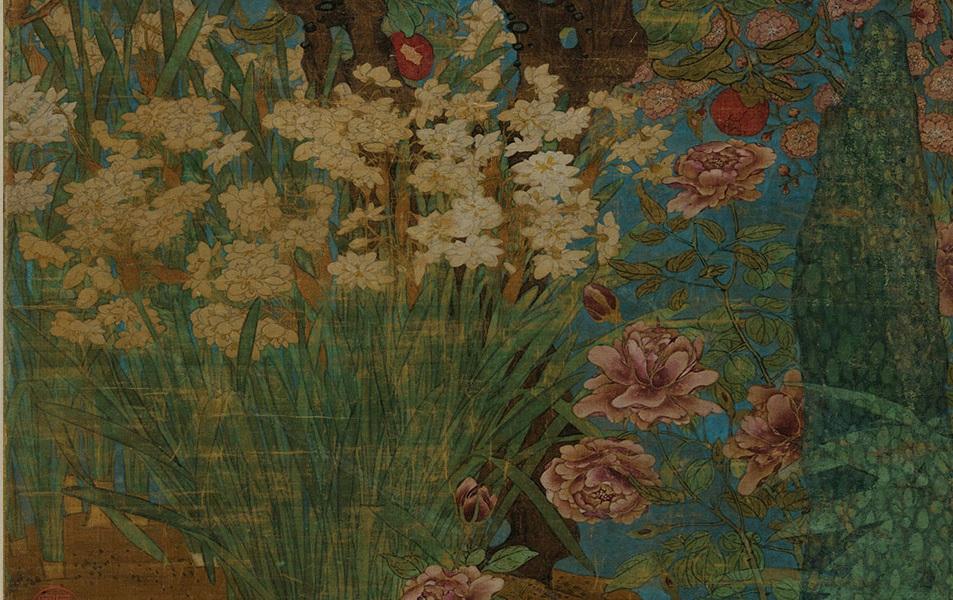
Translator's note: References to ex-president of China and now popular youth idol, Jiang Zemin, will be underlined. This will also be applied in future updates. Sorry for not being able to more accurately and subtly translate this kind of humor.
(Originally posted on Jan. 1st, 2018)
Greetings and best wishes for all of you guys on the first day of 2018~!
I opened this (Zhihu) column in last September and have been always grateful for your continuous attention and suggestions. "Your support is the core motive for my persistence" is definitely the gospel truth in this case here. If not for your following and upvoting, I must have long dropped out due to my own laziness _( :3」∠)_
(Translator's note: this emoji gets ruined somehow in the preview, so I added a space between the left parenthesis and the colon... feel free to let me know if there's any better alternative.)
So thank you guys!
Now that we've got more friends following, I feel like I should write something for our dear followers, and introduce the idea of this series in a concentrated manner, so that it will be easier to understand why I have constructed the series as I have till now...
For example,
Why I am doing this.
Starting as a kid who loves reading about history, I've always been keen to let loose my imagination. During these years I've imagined the following settings all with a certain degree of completeness:
In early 2017, pressured by the coming graduation, I began binge-watching Immature Magician (稚嫩的魔法师)'s video series on Paradox games, and quickly fell for Crusader Kings II (CK2). I soon found it was a great tool for my kind of world-setting projects. This opened up a new world for me who only knew about Europa Universalis.
Compared to thinking by oneself, games can help by adding a lot of uncontrollable/uncontrolled events and variations, which essentially does much of the work for the creator. All I needed to do is to rationalise and use my imagination. In fact the mechanism of CK2 which uses role activities as the main storyline is greatly suitable for this kind of things... a 100% freshly-created timeline would simply be completely unrealistic and un-compelling. Been there, done that, it's nothing like the depiction in actual historical records.
So, in the summer around my graduation, I consecutively started a few settings:
After giving it some thought, I found the story of Mahakhitan to be the most intriguing. After all it is about an Asian civilization which we would find naturally close. I also wanted to explore what an "Alternate China" without the influence of the Yuan-Ming-Qing art, Neo-Confucian and literati confinement would in turn be able to create. In the meantime I regarded it as a study project for me to look into the art history of Central and South Asia, and learn about how exactly do civilizations merge.
Also, why this is limited to art history and design history, while the rest all become the background...
Because I don't really know about the rest.
Because I wouldn't be able to read that much.
Because I also wouldn't be able to write that much.
You want me to talk about the military formation of Mahakhitan, about how the state promoted Buddhism and thus marginalised Hinduism, about what the Liao as the lingua franca was like... following my style of keeping everything compelling, it will undoubtedly include a LOT of details. I ain't a professional, I ain't able to do all that.
What I can do, however, is to not talk about things I don't know about, and to never do that kind of forced writing. I can be expected to keep the general direction on-track, intact and persuading. So if you guys ever catch things getting glossed over, that would be me with building not yet refined, or me really trying to avoid unfamiliar fields. But if you happen to want to help me refine things it would be superb.
Also, I have always been more interested in things that are physically visible, touchable, and I find it very entertaining to construct a fantasy world with as much details as possible. So my focus on architecture, religious art, clothing, folk culture, food, drama and so on should be considered the natural outcome~
The Reading Leave
Even so, there is much work left to be done.
The Grand Theatre series on Zheng He's story is in fact very challenging, as it includes everything. I intend to use this story as a general overview of the image of this civilisation in the 15th Century. The perspective of a mission coming from East Asia is also the most appropriate for our readers with East Asian backgrounds.
I have actually prepared quite a lot for the next chapter, but the description of the East Bazaar in the Central Capital, by my standard, is still not sufficiently compelling - although I do have experiences of working, bargaining, commuting (by bus) in South Asian cities, the building of a 15th-Century South Asian city belonging to a mixed civilization requires me to study more, and read more.
For example, in the part involving dining, I had to picture a suitable environment for the distinguished guests from Ming, and an appropriate Mahakhitan-style feast - which is not impossible, but requires some more thoughts. A balance point needs to be found between Afghan food, Punjabi food, Delhi food, traditional Central Asian food, etc. Reading traveling articles and even try the food out myself can barely be avoided ( /) V (\ )
Again for example, about female clothing in Mahakhitan. Men's clothes are easy to deduct. They are simple with less changes and the momentum to stay the same due to official requirements. But what about clothes for the girls? How long would it take Mahakhitan girls to give up the nomadic style and embrace Indian fashions? Which ornaments were to be inherited and which were not? These are all things to consider.
Also about literature, I'm still chewing through Mahabharata...
And about your guys' feedback about wanting to see more illustrations that I draw, I will try~ But it could require more graphic material as support and more time, so please forgive that.
I am a total perfectionist, especially when it comes to such projects. Of course I want it to be as best and compelling as possible. It's a conclusion for my history of years of imagination, after all.
Therefore, I am asking for a reading leave to you guys. This is because as I wrote and wrote I felt my accumulated knowledge was being depleted, especially my knowledge on South Asia, which I have lived in but am not sufficiently familiar with. I need to learn more to squeeze more. Also I have several big jobs to do in real life, so I will partition the Grand Theatre story into segments and update them one by one, instead of letting it all out in full length like before. Updates will come in at a slower pace, too. Please forgive this.
The original plan: why don't you keep playing?
Well in fact I proceeded with that save to 1444, and transferred it to Europa Universalis IV (EU4). I have been trying to play this for a few times, gotten familiar with the system, even had some clashes with Great Ming (not that this will be included in the official timeline story), and realised the extremely complex nature of the Liao-Ming relations. After that I've been reading and writing very hard - it's more fun than playing games~
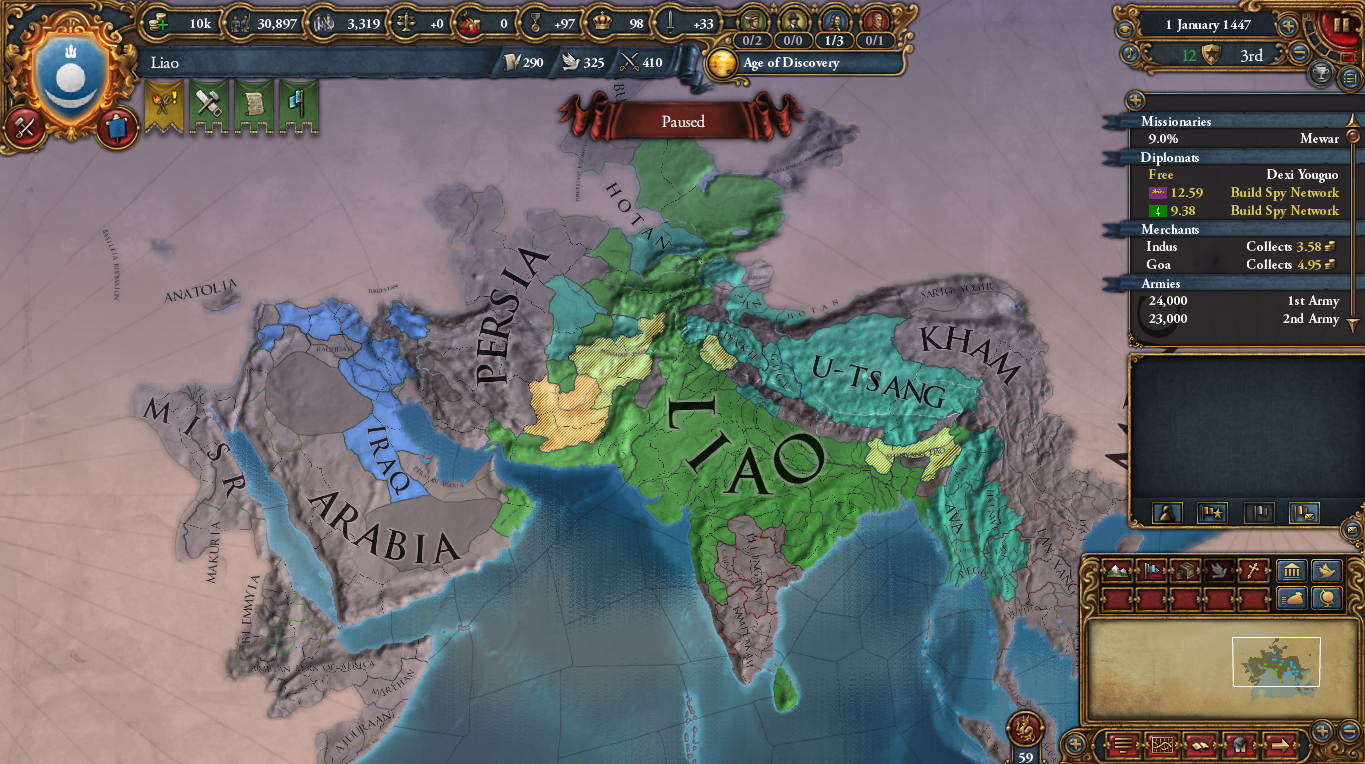
Recently I've decided to continue playing, and proceed to 1600 by February, so I will be able to write about how Mahakhitan would look like by 1600. And then I will go by one century each month, write about the civilisation in this era, with the final goal being moving into Hearts of Iron IV. We shall see the sky-shadowing iron wings of the Imperial Mahakhitan Air Force (IMAF) over the Euphrates, the Chittagong-Central Capital-Isfahan high-speed steam trains and oil pipes put into service, the imperial governor-general fighting with the British barbarians for land in Malacca and so on. We have a lot to talk about indeed.
In the foreseeable one to two centuries, as my EU4 gameplay is terrible, the empire would probably see a decline, which could in turn bring out many stories.
In the future there will probably be more content about wars and strategies, as compared to CK2, individuals in EU4 have much smaller roles. What a pity... ಸ_ಸ
Appendix: Below are a big part of the references until now. New items are still being slowly added. I've probably read 75% of them...
(Now that I'm abroad and nowhere near any university library, printed books are in short supply.)
If there are great books I don't know about, please do let me know~
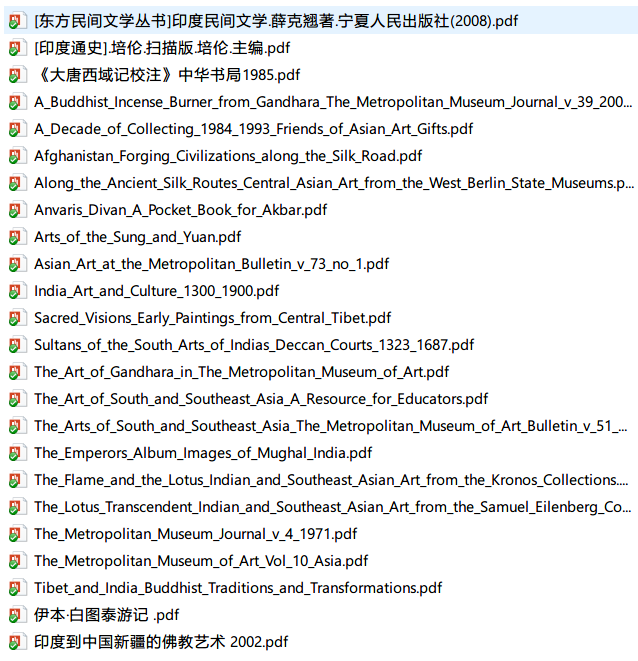




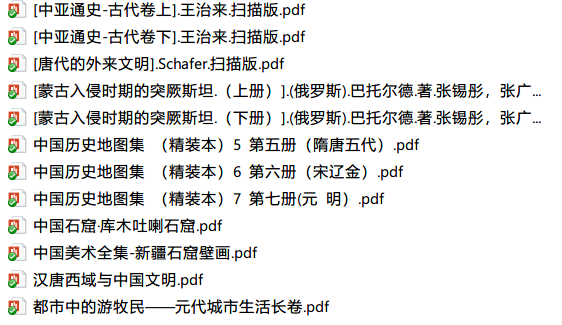
... And some research papers and stuff.
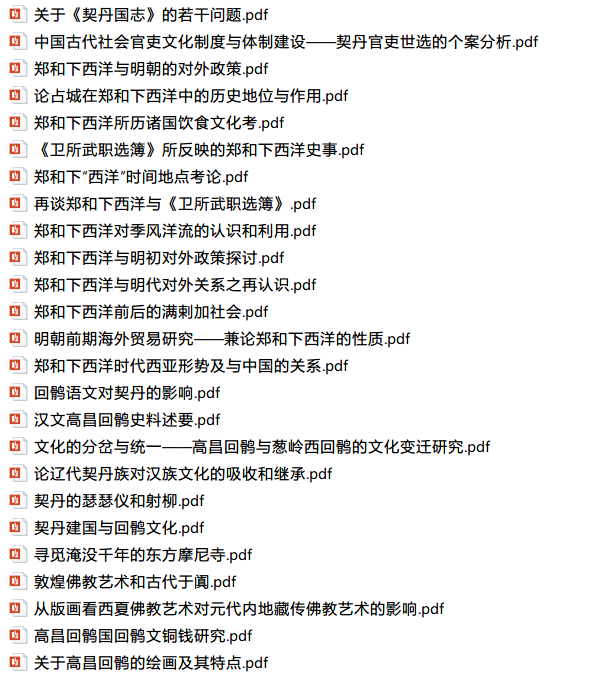
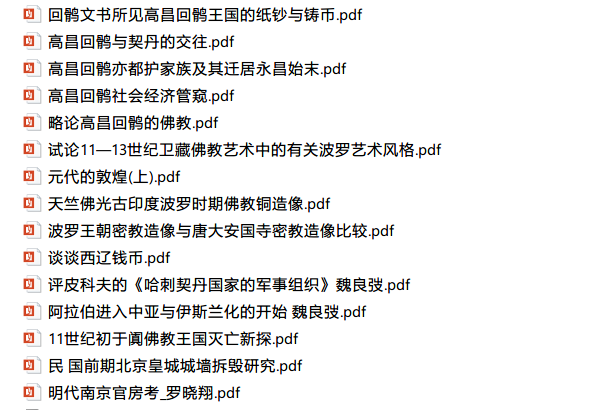
And lastly, the current flag and emblem of the empire:
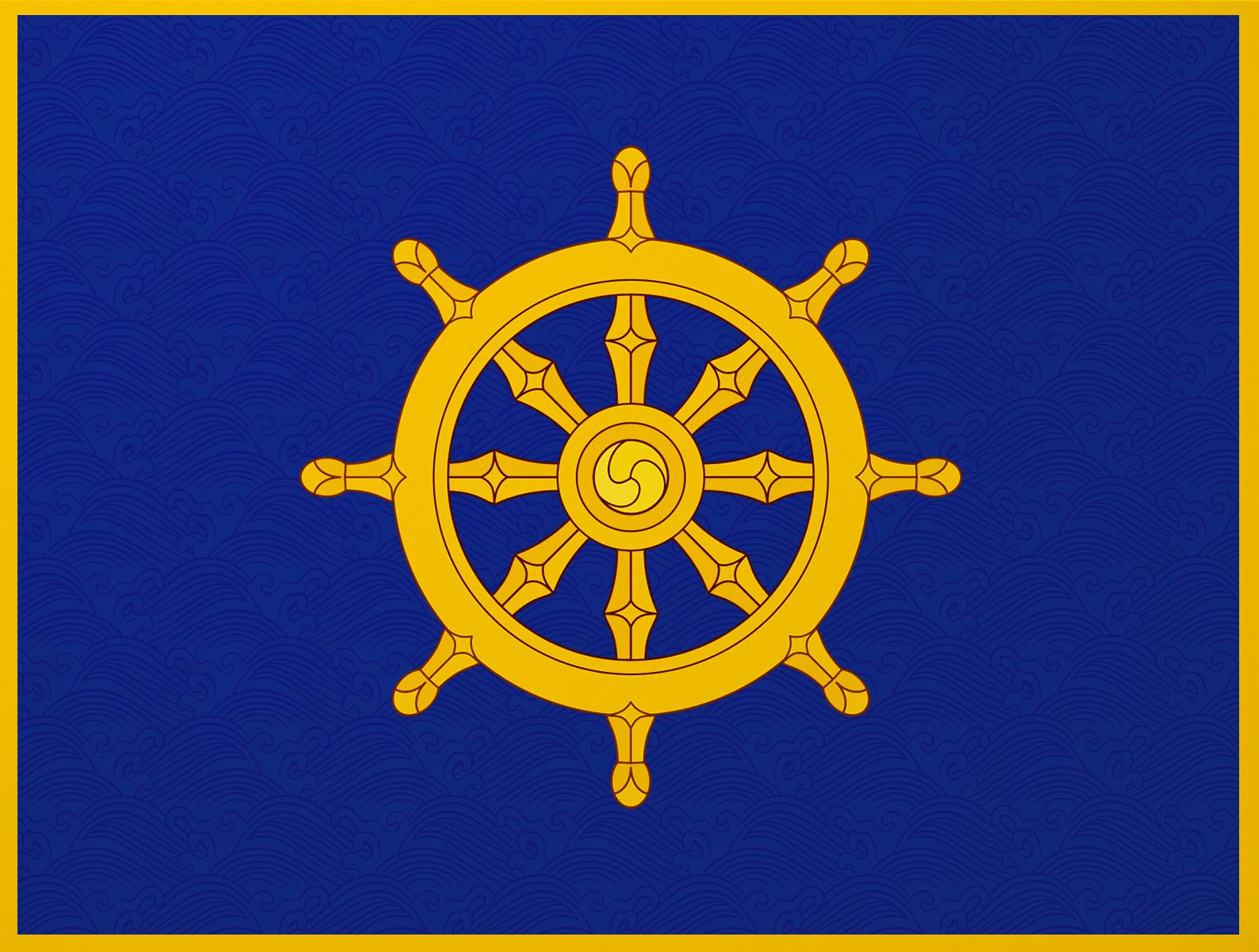
The flag of the Wheel-Turning Sagely King, Dharma and wisdom,
(Translator's note: apparently this is from the Great Treatise on the Perfection of Wisdom; but I have failed to locate the exact English translation of this seg of text so I did a literal/plain translation myself. A rough search in Chinese indicated this is from vol. 25 of the Buddhist classic.)
The bunting (ship flag) and navy flag have temporarily been determined to be the triangular blue field golden dragon and golden Makara flag. Let me think about how to draw it.
(Oh by the way, I don't believe in Buddhism. It's just for such a country the atmosphere needs to be like this~)
Finally, I wish everyone to be able to read the best books and visit the most beautiful places in the coming new year.
-Kara, in/at the snow-covered Windsor Tower, Cocoon Hall, Dec. 31st, 2017.
(One final n00b question: how do you import this national flag to EU4...)
新年快樂!一點微小的更新:旗幟、FAQ、以及近期計劃

Translator's note: References to ex-president of China
(Originally posted on Jan. 1st, 2018)
Greetings and best wishes for all of you guys on the first day of 2018~!
I opened this (Zhihu) column in last September and have been always grateful for your continuous attention and suggestions. "Your support is the core motive for my persistence" is definitely the gospel truth in this case here. If not for your following and upvoting, I must have long dropped out due to my own laziness _( :3」∠)_
(Translator's note: this emoji gets ruined somehow in the preview, so I added a space between the left parenthesis and the colon... feel free to let me know if there's any better alternative.)
So thank you guys!
Now that we've got more friends following, I feel like I should write something for our dear followers, and introduce the idea of this series in a concentrated manner, so that it will be easier to understand why I have constructed the series as I have till now...
For example,
Why I am doing this.
Starting as a kid who loves reading about history, I've always been keen to let loose my imagination. During these years I've imagined the following settings all with a certain degree of completeness:
- A eastern-Mediterranean medieval-style fantasy world (2007-2011)
- A Ming Dynasty-style steampunk worldview (2009-2011)
- A Fallout worldview set in my hometown Lanzhou, 60s-style (2010-2014)
In early 2017, pressured by the coming graduation, I began binge-watching Immature Magician (稚嫩的魔法师)'s video series on Paradox games, and quickly fell for Crusader Kings II (CK2). I soon found it was a great tool for my kind of world-setting projects. This opened up a new world for me who only knew about Europa Universalis.
Compared to thinking by oneself, games can help by adding a lot of uncontrollable/uncontrolled events and variations, which essentially does much of the work for the creator. All I needed to do is to rationalise and use my imagination. In fact the mechanism of CK2 which uses role activities as the main storyline is greatly suitable for this kind of things... a 100% freshly-created timeline would simply be completely unrealistic and un-compelling. Been there, done that, it's nothing like the depiction in actual historical records.
So, in the summer around my graduation, I consecutively started a few settings:
- In 1066, the Anglo-Saxon aristocrat Siward fled England under William's rule, held onto the thick, muscular and powerful legs of the Eastern Roman Empire, and founded Nova Anglia - the New England. Plus the art and culture in this little kingdom.
- In 769, a Latin baron in the Apennine mountain range, by juggling between different parties in the chaotic time, heavy-handedly unified Italy step by step, and finally rebuilt the Western Roman Empire. Plus the process of rebuilding the art and culture of the empire (the Flavian renaissance). I also read quite a lot for this.
- The next one is Mahakhitan, a story of Western Liao, under the pressure of the Mongols, relocating to India, consolidating its footings, and becoming a great empire in South Asia. Plus the art and culture in this East Asian - Central Asian - South Asian hybrid civilization.
After giving it some thought, I found the story of Mahakhitan to be the most intriguing. After all it is about an Asian civilization which we would find naturally close. I also wanted to explore what an "Alternate China" without the influence of the Yuan-Ming-Qing art, Neo-Confucian and literati confinement would in turn be able to create. In the meantime I regarded it as a study project for me to look into the art history of Central and South Asia, and learn about how exactly do civilizations merge.
Also, why this is limited to art history and design history, while the rest all become the background...
Because I don't really know about the rest.
Because I wouldn't be able to read that much.
Because I also wouldn't be able to write that much.
You want me to talk about the military formation of Mahakhitan, about how the state promoted Buddhism and thus marginalised Hinduism, about what the Liao as the lingua franca was like... following my style of keeping everything compelling, it will undoubtedly include a LOT of details. I ain't a professional, I ain't able to do all that.
What I can do, however, is to not talk about things I don't know about, and to never do that kind of forced writing. I can be expected to keep the general direction on-track, intact and persuading. So if you guys ever catch things getting glossed over, that would be me with building not yet refined, or me really trying to avoid unfamiliar fields. But if you happen to want to help me refine things it would be superb.
Also, I have always been more interested in things that are physically visible, touchable, and I find it very entertaining to construct a fantasy world with as much details as possible. So my focus on architecture, religious art, clothing, folk culture, food, drama and so on should be considered the natural outcome~
The Reading Leave
Even so, there is much work left to be done.
The Grand Theatre series on Zheng He's story is in fact very challenging, as it includes everything. I intend to use this story as a general overview of the image of this civilisation in the 15th Century. The perspective of a mission coming from East Asia is also the most appropriate for our readers with East Asian backgrounds.
I have actually prepared quite a lot for the next chapter, but the description of the East Bazaar in the Central Capital, by my standard, is still not sufficiently compelling - although I do have experiences of working, bargaining, commuting (by bus) in South Asian cities, the building of a 15th-Century South Asian city belonging to a mixed civilization requires me to study more, and read more.
For example, in the part involving dining, I had to picture a suitable environment for the distinguished guests from Ming, and an appropriate Mahakhitan-style feast - which is not impossible, but requires some more thoughts. A balance point needs to be found between Afghan food, Punjabi food, Delhi food, traditional Central Asian food, etc. Reading traveling articles and even try the food out myself can barely be avoided ( /) V (\ )
Again for example, about female clothing in Mahakhitan. Men's clothes are easy to deduct. They are simple with less changes and the momentum to stay the same due to official requirements. But what about clothes for the girls? How long would it take Mahakhitan girls to give up the nomadic style and embrace Indian fashions? Which ornaments were to be inherited and which were not? These are all things to consider.
Also about literature, I'm still chewing through Mahabharata...
And about your guys' feedback about wanting to see more illustrations that I draw, I will try~ But it could require more graphic material as support and more time, so please forgive that.
I am a total perfectionist, especially when it comes to such projects. Of course I want it to be as best and compelling as possible. It's a conclusion for my history of years of imagination, after all.
Therefore, I am asking for a reading leave to you guys. This is because as I wrote and wrote I felt my accumulated knowledge was being depleted, especially my knowledge on South Asia, which I have lived in but am not sufficiently familiar with. I need to learn more to squeeze more. Also I have several big jobs to do in real life, so I will partition the Grand Theatre story into segments and update them one by one, instead of letting it all out in full length like before. Updates will come in at a slower pace, too. Please forgive this.
The original plan: why don't you keep playing?
Well in fact I proceeded with that save to 1444, and transferred it to Europa Universalis IV (EU4). I have been trying to play this for a few times, gotten familiar with the system, even had some clashes with Great Ming (not that this will be included in the official timeline story), and realised the extremely complex nature of the Liao-Ming relations. After that I've been reading and writing very hard - it's more fun than playing games~

Recently I've decided to continue playing, and proceed to 1600 by February, so I will be able to write about how Mahakhitan would look like by 1600. And then I will go by one century each month, write about the civilisation in this era, with the final goal being moving into Hearts of Iron IV. We shall see the sky-shadowing iron wings of the Imperial Mahakhitan Air Force (IMAF) over the Euphrates, the Chittagong-Central Capital-Isfahan high-speed steam trains and oil pipes put into service, the imperial governor-general fighting with the British barbarians for land in Malacca and so on. We have a lot to talk about indeed.
In the foreseeable one to two centuries, as my EU4 gameplay is terrible, the empire would probably see a decline, which could in turn bring out many stories.
In the future there will probably be more content about wars and strategies, as compared to CK2, individuals in EU4 have much smaller roles. What a pity... ಸ_ಸ
Appendix: Below are a big part of the references until now. New items are still being slowly added. I've probably read 75% of them...
(Now that I'm abroad and nowhere near any university library, printed books are in short supply.)
If there are great books I don't know about, please do let me know~






... And some research papers and stuff.


And lastly, the current flag and emblem of the empire:

The flag of the Wheel-Turning Sagely King, Dharma and wisdom,
Imperial Flag and flag of the Central Army of Mahakhitan in the early 15th Century
国旗的出处:“转轮圣王手转宝轮,空中无碍。佛转法轮,一切世间天及人中无碍无遮,其见宝轮者诸灾恶害皆灭。”
The Wheel-Turning Sage turns the precious wheel in his hands, without any obstruction in the air. The Buddha turns Dharmachakra, Wheel of the Dharma, without any obstruction nor concealment in the worlds, in which those who see the Wheel are removed of all kinds of disasters, troubling and evils.
(Translator's note: apparently this is from the Great Treatise on the Perfection of Wisdom; but I have failed to locate the exact English translation of this seg of text so I did a literal/plain translation myself. A rough search in Chinese indicated this is from vol. 25 of the Buddhist classic.)
The bunting (ship flag) and navy flag have temporarily been determined to be the triangular blue field golden dragon and golden Makara flag. Let me think about how to draw it.
(Oh by the way, I don't believe in Buddhism. It's just for such a country the atmosphere needs to be like this~)
Finally, I wish everyone to be able to read the best books and visit the most beautiful places in the coming new year.
-Kara, in/at the snow-covered Windsor Tower, Cocoon Hall, Dec. 31st, 2017.
(One final n00b question: how do you import this national flag to EU4...)
Last edited:
-snip-
I feel you should wait for his ok first and discuss in the conversation before posting. I mean, most of us (I hope) are working people or students. We may not have much time to spare. ._.
I feel you should wait for his ok first and discuss in the conversation before posting. I mean, most of us (I hope) are working people or students. We may not have much time to spare. ._.
You are right. I will message him again...
What's tricky is that he should have received and read the drafts of the following 4 updates (1 big and 3 small, excluding the one I've already posted above which I just translated in real-time), so I imagine he could have just trimmed some wording and sentences and posted those...
You are right. I will message him again...
What's tricky is that he should have received and read the drafts of the following 4 updates (1 big and 3 small, excluding the one I've already posted above which I just translated in real-time), so I imagine he could have just trimmed some wording and sentences and posted those...
Like I said, we can be very busy. I have two TLs running and both are long overdue for an update. I imagine he is more so.
Threadmarks
View all 51 threadmarks
Reader mode
Reader mode
Recent threadmarks
Chapter 27 Mahakhitan Kaleidoscope (1): A Brief Introduction to the Empire’s Administrative Branch in 18th Century Chapter 28 Mahakhitan Kaleidoscope (2): Mahakhitan Vexillology, and Brief Introduction to the Country’s Army and Navy Bonus 006: Dimensions of the South Asian Subcontinent, Among Other Things Chapter 29 Stories of Mahakhitan Porcelain Art (Part One) Bonus 008: Preview of the Mahakhitan State mod For Victoria II. Original Historical Material: The Mahakhitan Chronicle (1632-1760) Chapter 30 Stories of Mahakhitan Porcelain Art (Part Two) Chapter 040, An Illustrated Guide to South City Wards.
Share: